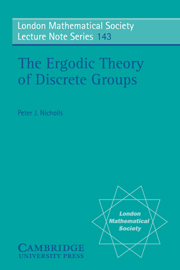Book contents
- Frontmatter
- Contents
- CHAPTER 1 Preliminaries
- CHAPTER 2 The Limit Set
- CHAPTER 3 A Measure on the Limit Set
- CHAPTER 4 Conformal Densitites
- CHAPTER 5 Hyperbolically Harmonic Functions
- CHAPTER 6 The Sphere at Infinity
- CHAPTER 7 Elementary Ergodic Theory
- CHAPTER 8 The Geodesic Flow
- CHAPTER 9 Geometrically Finite Groups
- CHAPTER 10 Fuchsian Groups
- REFERENCES
- INDEX OF SYMBOLS
- INDEX
CHAPTER 10 - Fuchsian Groups
Published online by Cambridge University Press: 18 December 2009
- Frontmatter
- Contents
- CHAPTER 1 Preliminaries
- CHAPTER 2 The Limit Set
- CHAPTER 3 A Measure on the Limit Set
- CHAPTER 4 Conformal Densitites
- CHAPTER 5 Hyperbolically Harmonic Functions
- CHAPTER 6 The Sphere at Infinity
- CHAPTER 7 Elementary Ergodic Theory
- CHAPTER 8 The Geodesic Flow
- CHAPTER 9 Geometrically Finite Groups
- CHAPTER 10 Fuchsian Groups
- REFERENCES
- INDEX OF SYMBOLS
- INDEX
Summary
Introduction
In this chapter we will specialize to the case n = 2, A discrete group preserving the unit ball (disc) B in R2 is a Fuchsian group. We are singling out this special class of groups for special attention because it will give us the opportunity to do two things.
We give a different presentation of the line element space, flows on this space, and measures invariant under the flow. In contrast to our previous derivation, which was entirely geometric, we adopt an algebraic approach. This has the advantage of yielding algebraic formulae for the flows which can be handled with more facility than the somewhat descriptive geometric notions. Our approach is modeled on the work of Fomin and Gel'fand [Fomin and Gel'fand, 1952].
We introduce the horocycle flow. This flow is closely related to the geodesic flow and we will exploit the relationship to derive ergodic properties of both flows. Additionally we will find that the horocycle flow enjoys properties (minimality, unique ergodicity) which the geodesic flow does not. The horocycle flow can be defined in n-dimensions, indeed it was introduced in this generality by Hopf [Hopf, 1939], and has been studied by many authors. However, it is simplest, and in some senses most natural, to introduce it in the two-dimensional setting.
We will present an account of ergodic phenomena for Fuchsian groups which is essentially independent of the treatment in chapter 8. This has the advantage of making the chapter self contained and, more importantly, of demonstrating proofs of the ergodic theorems which exploit the connection between the geodesic and horocyclic flows.
- Type
- Chapter
- Information
- The Ergodic Theory of Discrete Groups , pp. 161 - 208Publisher: Cambridge University PressPrint publication year: 1989



